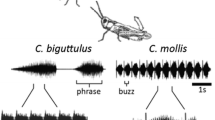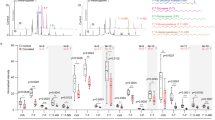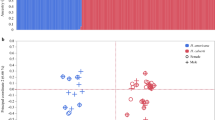Abstract
We investigated the role that courtship and aggressive interactions may have for the maintenance of reproductive isolation betweenDrosophila silvestris andD. heteroneura. We examined the behavioral bases of reproductive isolation between the parental species and we examined the courtship success of each sex of both reciprocal F1 hybrids when paired with the parental species. We found reduced copulation success among heterotypic parental pairs compared to homotypic pairs, which was primarily due to the lack of courtship initiation betweenD. silvestris males andD. heteroneura females. When hybrid males from both reciprocal crosses were paired with parental females their copulation successes were not significantly different from that of parental males. In contrast, hybrid females from both crosses had reduced copulation success withD. silvestris males, which in turn was primarily due to a reduced success of reaching later stages of courtship. The time spent in copulation by hybrid males was intermediate between the two parental males. We studied aggression by observing the interactions of males of heterotypic pairs, both between the parental species and between the hybrids and parental males. A lack of aggressive interactions betweenD. silvestris males andD. heteroneura males in addition to the lack of courtship suggests thatD. silvestris males do not respond toD. heteroneura individuals of either sex. Hybrid males were equally successful in winning fights with bothD. silvestris andD. heteroneura males. These results indicate that the behavioral isolation betweenD. silvestris andD. heteroneura may be largely a consequence of the earliest stages of interactions. The two species may differ either in activity levels or in morphological or chemical traits that are important for species and mate recognition. The relatively high copulation and aggressive success of hybrids indicates that sexual selection against hybrids alone is unlikely to be a sufficient force to reduce gene flow and maintain species distinctions.
Similar content being viewed by others
References
Ahearn, J. N., and Templeton, A. R. (1989). Interspecific hybrids ofDrosophila heteroneura andD. silvestris. I. Courtship success. Evolution43 347–361.
Boake, C. R. B. (1984). Male displays and female preferences in the courtship of a gregarious cricket.Anim. Behav. 32 690–697.
Boake, C. R. B. (1989). Correlations between courtship success, aggressive success, and body size in a picture-winged fly,Drosophila silvestris.Ethology 80 318–329.
Boake, C. R. B., and Hoikkala, A. (1995). Courtship behavior of wild-caughtDrosophila silvestris males.Anim. Behav.,49 1303–1313.
Butlin, R. (1987). Speciation by reinforcement.Trends Ecol. Evol. 2 8–13.
Carson, H. L. (1982). Evolution ofDrosophila on the newer Hawaiian volcanoes.Heredity 48 3–25.
Carson, H. L. (1987). High fitness of heterokaryotypic individuals segregating naturally within a long-standing laboratory population ofDrosophila silvestris.Genetics 116 415–422.
Carson, H. L., Kaneshiro, K. Y., and Val, F. C. (1989). Natural hybridization between the sympatric Hawaiian speciesDrosophila silvestris andDrosophila heteroneura.Evolution 43 190–302.
Conant, P. (1978). Lek behavior and ecology of two sympatric homosequential HawaiianDrosophila: Drosophila heteroneura andDrosophila silvestris. Master's thesis, University of Hawaii.
Coyne, J. A. (1992). Genetics and speciation.Nature 355 511–515.
Craddock, E. M. (1974). Reproductive relationships between homosequential species of HawaiianDrosophila.Evolution 28 593–606.
Fagen, R. M., and Young, D. Y. (1978). Temporal patterns of behaviors: Durations, intervals, latencies, and sequencies. In Colgan, P. W. (ed.),Quantitative Ethology, Wiley, New York, pp. 79–114.
Houck, L. D., Arnold, S. J., and Thisted, R. A. (1985). A statistical study of mate choice: Sexual selection in a plethodontid salamander (Desmognathus ochrophaeus).Evolution 39 370–386.
Hoy, R. R., Hoikkala, A., and Kaneshiro, K. Y. (1988). Hawaiian courtship songs: Evolutionary innovation in communication signals ofDrosophila.Science 240 217–219.
Jallon, J.-M., and David, J. R. (1987). Variations in cuticular hydrocarbons among the eight species of theDrosophila melanogaster subgroup.Evolution 41 294–302.
Kaneshiro, K. Y. (1976). Ethological isolation and phylogeny in thePlanitibia subgroup of HawaiianDrosophila.Evolution 30 740–745.
Krebs, R. A. (1990). Courtship behavior and control of reproductive isolation inDrosophila mojavensis: Genetic analysis of population hybrids.Behav. Genet. 20 535–543.
Lande, R. (1981). Models of speciation by sexual selection on polygenic traits.Proc. Natl. Acad. Sci. USA 78 3721–3725.
Lande, R., and Kirkpatrick, M. (1988). Ecological speciation by sexual selection.J. Theoret. Biol. 133 85–98.
Markow, T. A., and Toolson, E. C. (1990). Temperature effects on epicuticular hydrocarbons and sexual isolation inDrosophila mojavensis. In Barker, J. S. F., Starmer, W. T., and MacIntyre, R. J. (eds.),Ecological and Evolutionary Genetics of Drosophila, Plenum Press, New York, pp. 315–331.
Paterson, H. E. H. (1985). The recognition concept of species. In Vrba, E. S. (ed.),Species and Speciation, Transvaal Museum Monograph No. 4, Transvaal Museum, Pretoria, South Africa, pp. 21–29.
Reyment, R. A., Blacklith, R. E., and Campbell, N. A. (1984).Multivariate Morphometrics, 2nd ed. Academic Press, New York.
Robertson, F. W. (1963). The ecological genetics of growth inDrosophila: 6. The genetical correlation between the duration of the larval period and body size in relation to larval diet.Genet. Res. 4 74–92.
Schwartz, J. M., and Boake, C. R. B. (1992). Sexual dimorphism in remating in HawaiianDrosophila species.Anim. Behav. 44 231–238.
Sokolowski, M. B., and Bauer, S. J. (1989). Genetic analyses of pupation distance inDrosophila melanogaster.Heredity 62 177–183.
Spieth, H. T. (1978). Courtship patterns and evolution of theDrosophila adiastola andplanitibia series subgroups.Evolution 32 435–451.
Spieth, H. T. (1981).Drosophila heteroneura Head shapes, behavior and evolution.Evolution 35 921–930.
Spieth, H. T., and Ringo, J. M. (1983). Mating behavior and sexual isolation inDrosophila. In: Ashburner, M., Carson, H. L., and Thompson, J. M. (eds.),The Genetics and Biology of Drosophila, Vol. 3e, Academic Press, New York, pp. 223–284.
Stearns, S. C., and Koella, J. C. (1986). The evolution of phenotypic plasticity in life-history traits: Predictions of reaction norms for age and size at maturity.Evolution 40 893–913.
Templeton, A. R. (1977). Analysis of head shape differences between two interfertile species of HawaiianDrosophila.Evolution 31 630–641.
Tompkins, L. (1989). Homosexual courtship inDrosophila. In Carew, T. J., and Kelley, D. B. (eds.),Perspectives in Neural Systems and Behavior, Alan Liss, New York, pp. 229–248.
Val, F. C. (1977). Genetic analysis of the morphological differences between two interfertile species of HawaiianDrosophila.Evolution 31 611–629.
Verrell, P. A., and Arnold, S. J. (1989). Behavioral observations of sexual isolation among allopatric populations of the mountain dusky salamander,Desmognathus ochrophaeus.Evolution 43 745–755.
Watson, G. F. (1979). On premating isolation between two closely related species of HawaiianDrosophila.Evolution 33 771–774.
Author information
Authors and Affiliations
Rights and permissions
About this article
Cite this article
Price, D.K., Boake, C.R.B. Behavioral reproductive isolation inDrosophila silvestris, D. heteroneura, and their F1 hybrids (Diptera: Drosophilidae). J Insect Behav 8, 595–616 (1995). https://doi.org/10.1007/BF01997233
Issue Date:
DOI: https://doi.org/10.1007/BF01997233




